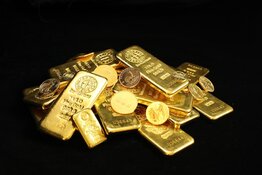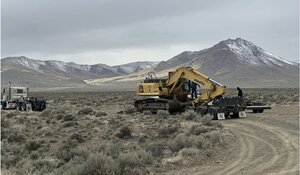The Metals Report: Paul, you're based in London and introduce European investors to small-cap resource equities, many of which are listed and domiciled in Canada. Do you think European investors have a stronger appetite for mining equities?
Paul Renken: I don't think European investors have a stronger appetite than, say, the marketplace in Canada. However, European investors do have some interest in mining equities, particularly for those stories that are more advanced.
TMR: It's been a relatively good August for gold, silver and some of the base metals. Are you noticing an uptick in interest in resource equities from institutional and retail investors?
PR: Our activity actually picked up within weeks after the gold and silver prices fell in April. Particularly in the private equity space, firms were sniffing around for good bargains, good projects with relatively good grades that no longer had decent outlets to get funded. This would include early-stage projects that aren't to the point where they can take a feasibility study to the bank for conventional financing. Some investors were interested in picking up a bargain in this space, investing in companies with extremely low valuations.
TMR: One aspect of junior resource equities is that you pay particular attention to a company's narrative. What are the key aspects of a saleable narrative?
PR: We see an awful lot of stories come through our doors, both on listed and unlisted corporate situations. What we find is most saleable, in terms of being able to find the equity financing that they're looking for, are high-grade deposits. That is what investors are looking for. They're also looking for a corporate story or business model that is quite simple. They're not looking for companies with many different types of commodity assets across a whole host of countries. Investors want simple, focused stories where it's easy to develop to the cash flow stage. Low development cost is another selling point. Investors have been looking for companies that aren't cash constrained at the moment—they don't want companies that are desperate for any kind of a deal at any kind of a price in order to get some cash. Finally, to a lesser extent, investors are looking for situations with minimal equity dilution and few if any warrants outstanding.
TMR: Give us a couple of examples of junior resource equities with narratives that you took an interest in.
PR: A company that has been a client of ours is Fission Uranium Corp. (FCU:TSX.V), which is a co-venture partner of Alpha Minerals Inc. (AMW:TSX.V) on the Patterson Lake South uranium discovery in the Athabasca Basin. That story is an easy, saleable narrative because it's quite high grade, and it's a new discovery. The drill results are well within the range of minable assays for uranium. Now it's just a question of determining the size of the uranium deposit. It's also quite shallow mineralization in comparison to other discoveries in the Athabasca Basin. That would indicate that the project will be very cost competitive with existing mines in the region, if it has sufficient size.
TMR: Another one?
PR: Another example would be Eagle Star Minerals Corp. (EGE: TSX-V). It's a company with a surface discovery of phosphate mineralization in Brazil. Phosphate is a fertilizer that is in quite short supply in Brazil, a country that is one of the big agricultural centers in the world. Brazil needs these fertilizers because the soils there were not geologically glacially enriched. In other words, they've been weathered a very long time and are deficient in minerals like potassium and phosphate, minerals that increase yields. Eagle Star's phosphate is right at surface. The grades are well in excess of what other miners are currently producing in Brazil. This story has all the indications of a saleable product. The capex will be pretty low overall. Eagle Star is right next to an operating mine and is able to do very quick comparisons on the basis of grades and capital costs as it develops its project.
TMR: What commodities is VSA interested in right now?
PR: Anybody that is in mining equities of course is interested in gold and silver because the commodities are highly liquid once they're produced. We like gold and silver companies, but we're also interested in lead-zinc mineralization and nickel. Also, we're kind of specialists in tungsten and minor metals.
TMR: Where are we at with base metals?
PR: Base metals carry a mixed bag of possibilities. Copper, lead and zinc are looking very good, but nickel is not so strong at this point. That has a lot to do with where the demand lies in Asia, specifically in China, and whether there is a lot of inventory in warehouses at the moment. Nickel warehouse inventories are at five-year highs and are still climbing. Meanwhile, copper warehouse inventories are coming down, which means that copper is being delivered to the smelters and mills in order to be fabricated.
TMR: What are some copper plays you're following?
PR: We didn't think the major producers, the top-tier names, would do that well simply because we didn't quite see the strength in the marketplace for copper. At the same time, we saw the development of these new copper exchange-traded product instruments. We thought some of that copper was going to get taken up into inventory, and expected copper itself to perform better than the top-tier names. We thought second-tier producers might perform better in this situation, producing companies that aren't the first names that come to mind but that are either expanding their capacity or located in safe jurisdictions. We're talking about names there like First Quantum Minerals Ltd. (FM:TSX; FQM:LSE) or Taseko Mines Ltd. (TKO:TSX; TGB:NYSE.MKT).
TMR: What about zinc?
PR: Zinc we're pretty positive on actually, particularly for 2014-2015, for three particular reasons. First of all, we feel underinvestment in zinc is going to cause some supply constraints in 2014, particularly because some of the really large deposits are reaching the end of their life throughout the world, such as the Century deposit in Australia. The New Brunswick smelter is now being closed, so the availability is going to become more constrained as we head into 2014. Another constructive thing for zinc we feel is the Glencore International Plc (GLEN:LSE) / Xstrata Plc (XTA:LSE) merger, which essentially further constrains the alternative to supply out there, particularly seaborne supply. Just as the iron ore space is dominated by a few major seaborne players, we think that there will be just a few players in seaborne zinc concentrate in 2014-2015.
TMR: How can investors get zinc exposure?
PR: We like some of the junior players here, especially preproduction stories with very sizable deposits the majors will be interested in. Rathdowney Resources Ltd.'s (RTH:TSX.V) great big Olza sediment-hosted deposit in Poland certainly is one that comes to mind there. It's one of the 20 largest, undeveloped deposits in the world, and it also happens to lie next door to a smelter that is running out of supply from existing mines. So it's logical that the Olza deposit will be brought into production as the old mine depletes.
TMR: Rathdowney published some metallurgical results in June. As a geologist, what did you make of those?
PR: The metallurgical results were pretty much as we expected compared to immediately adjacent operations. All the indications are of a similar age and type of mineralization to the current operating mine to the south of them. So those numbers were well within the expectations that we had.
TMR: What about juniors?
"High-grade deposits and a corporate story or business model that's simple – that is what investors are looking for."
PR: As far as the other junior names out there, North River Resources Plc (NRRP:LSE) wants to bring the Namib lead-zinc mine back into production in Namibia. It's a mine that has produced in the past but had closed due to the decline in lead-zinc prices 15 years ago. But the grades indicate the ore shoots are well into the economic range, which suggests the mine could and should be brought back into production. And it can be done relatively quickly, particularly because the company is starting by treating the mill tailings that are lying right there at surface with a simple gravity or flotation circuit. It would be a low capex to bring that into production.
A larger company that has been around for a little while is Silvercorp Metals Inc. (SVM:TSX; SVM:NYSE) within the Ying mining district in China, which certainly has been very profitable and consistent. Griffin Mining Ltd. (GFM:LSE) is a zinc-gold producing company in China. Down at the very speculative end of the market is a Canadian, Peru-based company by the name of Vena Resources Inc. (VEM:TSX.V; VEM:BVL; V1R:FSE).
TMR: Are you following any nickel plays despite your pessimism toward the commodity itself?
PR: We actually follow quite a number of companies because we have some clientele in the space and we are interested in the direction of the metal itself. There are some junior nickel plays in the London market that have attracted interest over the years, particularly from retail investors.
African Eagle Resources Plc (AFE:LSE; AEA:JSE) and Horizonte Minerals Plc (HZM:LSE; HZM:TSX). They have development-stage laterite projects. In the first case, African Eagle, is in Tanzania with the Dutwa nickel laterite. Horizonte has a major nickel laterite project in Brazil. African Eagle has essentially struggled to get any interest in it, so it has made it known that it wants someone to essentially take it over or buy it out. In that sense, it's definitely a takeover play situation. In Horizonte's case, it is on an adjoining land position to operations that are already producing from laterites. It intends to develop its laterite under a mill and smelt process that is already being used in Brazil. So it is not trying to reinvent the wheel. It is just trying to do what's already being done profitably in Brazil.
Royal Nickel Corp. (RNX:TSX) has the Dumont project in Quebec. The key attribute for that particular story is how big the deposit is as far as contained nickel is concerned. We're looking at a 30- or 40-year mine life if it can be profitably developed. All the indications suggest it is potentially economic. But it's going to take a really sizable capital investment, something in the range of $1 billion ($1B) or more, in order to bring it on. It is going to have long life for a particular strategic investor or mining smelter company, whatever it may be that is looking for a long-term, sustainable supply of nickel. So it still may be one that ends up getting financed. Any kind of a junior story that gets financed these days typically has a very nice run in the stock. The platinum group metal (PGM) byproducts are going to be frosting on the cake.
TMR: There is a Chinese partner in place. How would it contribute to developing that asset?
PR: That partner has a particular interest in being able to produce a steel product without going through the separate enrichment step for nickel. So in that sense, I think it has a particular interest in helping that financing get done because it needs feed for the next couple of decades.
TMR: You brought up tungsten earlier. That is a very niche product, but it's increasingly in demand due to its ability to resist heat and its incredible hardness. Tell us about the market for tungsten.
PR: The marketplace for tungsten was really hammered during the late 1980s and early 1990s because the Chinese low-production-cost scheelite mines have forced non-Asian players more or less out of the market. But now China has depleted its higher-grade deposits, and its manufacturing capacity is such that it wants to maintain what supply it has in-country from the mining aspect for its own use. This means that the rest of the world, which hasn't made any tungsten investment of any size in the recent 10–15 years, is looking for alternative supplies. There are some deposits out there, both relatively small, higher-grade shear zone and vein-hosted deposits that have reasonable possibility for being profitable, as well as larger deposits of the skarn or porphyry type that have more or less languished for some period of time. Now those projects are definitely getting a second look.
One of the larger deposits is the Sisson project in New Brunswick, which is held by Northcliff Resources Ltd (NCF:TSX.V). The Sisson project has been around for more than 20 years, waiting to be developed. It's a skarn tungsten deposit with some byproduct of molybdenum as well. All the indications are that it should be developed now simply because of its size of contained tungsten. It would indicate that it has a 20- or 30-year mine life, so any potential partners who want a sustained source of reliable supply outside of China would be considering financing that deposit.
Another deposit is one we have right here in the UK called Hemerdon, which used to be in fact a clay property. For a couple of decades now, it has been known to have underneath the weathered clay material tin and tungsten. Now, a company out of Australia called Wolf Minerals Ltd. (WLF:ASX) is putting that deposit into production.
TMR: Would you consider Largo Resources Ltd. (LGO:TSX.V) a tungsten or vanadium play?
"Institutions and private equity have already been jumping into bargain hunting, but now it's the retail market's turn."
PR: Largo is definitely a vanadium play. It does have a pair of tungsten projects, one of which is a tailings retreatment project that's been put back on care and maintenance in Northern Brazil but also a large, undeveloped tungsten deposit called Northern Dancer in Canada. The Maracas vanadium deposit in Brazil received financing from Glencore-Xstrata and is under construction. Glencore recognized that this is one of the highest-grade vanadium deposits in the world at 1.3% vanadium. The geology indicates there is an awful lot more vanadium potential along this particular trend and should pay dividends for a company like Glencore, which has the offtake of vanadium, for a long time.
TMR: Would you say you're bullish on vanadium in general?
PR: We're generally constructive on vanadium. Ferrovanadium makes up 90% of the market for vanadium, which means that it ends up competing against other materials of steel-blended products. It competes against moly-steel, nickel-steel or chrome-steel in various applications, depending upon specifications. A lot of press has been targeting vanadium, however, on the basis of its battery potential. Vanadium redox batteries are a small segment of overall vanadium usage, but if they prove to be a longer-term means of electricity storage for wind and solar energy, then it changes the whole demand picture for vanadium.
TMR: Let's get to rare earth elements (REEs). What equities are you following in that space?
PR: Roughly a couple of hundred names came into the REE space since 2010, whereas now only several dozen names have demonstrated viable projects. One name is Mkango Resources Ltd. (MKA:TSX.V). It has an REE project in Malawi. That particular deposit outcrops at surface. All the indications are that it's quite sizable. It has done enough drilling on it to indicate that it is of commercial size. It now has to work out the exact liberation process that it wants to use as far as milling is concerned to produce a concentrate. Avalon Rare Metals Inc. (AVL:TSX; AVL:NYSE; AVARF:OTCQX) has a Northern Canada deposit. It has some capex issues behind it that it still has yet to overcome, but it is also a very sizable deposit.
The two names in the commercial space that people have been following in recent years are Molycorp Inc. (MCP:NYSE) and Lynas Corp. (LYC:ASX). Both of those companies now are either in production or about to be in production. Lynas had permitting and social acceptance problems, and Molycorp had cost overruns in trying to get its deposits up and running. So it's definitely a challenging space for investors to make money in.
TMR: As far as Mkango goes, it is focused this year on getting the Songwe Hill prefeasibility study done. What are your expectations for that?
PR: One of the things I like about Mkango is it hasn't overpromised and underdelivered. It is just the opposite. It has played quite conservatively as to what it thinks it can achieve and at what costs. Like all of the other juniors that are in the preproduction phase, it has struggled to raise money at a time when equity has been more and more discounted, particularly for exploration-stage projects. Nonetheless, the deposit is a good deposit. So I think the outlook has improved for the company. It just has to show with the prefeasibility study that it can commercially produce. We remain constructive on the firm.
TMR: Do you have any parting thoughts for the investors reading this article?
PR: Institutions and private equity have already been jumping into bargain hunting, but now it's the retail market's turn as we go into the autumn. The marketplace overall has been oversold this summer and there is some significant upside in some corporate stories, even if the metals prices overall are not in a boom period. The stocks have a little bit of catch-up to do, so there's some good profits to be made.
TMR: Thank you, Paul.
Paul Renken has a broad range of experience in various aspects of the mining and minerals business. He began his career as a geologist for Canadian junior resource companies in the Western United States. Owning a stake in a private consulting firm as vice president of exploration, Renken searched for various base metals, precious metals and industrial minerals. In the UK, he worked in the equity market media outlets of Digitallook and Hemscott before joining VSA as mining analyst in 2006.
Want to read more Metals Report interviews like this? Sign up for our free e-newsletter, and you'll learn when new articles have been published. To see a list of recent interviews with industry analysts and commentators, visit our Metals Report homepage.
DISCLOSURE:
1) Brian Sylvester conducted this interview for The Metals Report and provides services to The Metals Report as an independent contractor. He or his family own shares of the following companies mentioned in this interview: None.
2) The following companies mentioned in the interview are sponsors of The Metals Report: Royal Nickel Corp. Streetwise Reports does not accept stock in exchange for its services or as sponsorship payment.
3) Paul Renken: I or my family own shares of the following companies mentioned in this interview: None. I personally am or my family is paid by the following companies mentioned in this interview: None. My company has a financial relationship with the following companies mentioned in this interview: Northcliff, Largo, Royal Nickel, Vena Resources, North River and Eagle Star. I was not paid by Streetwise Reports for participating in this interview. Comments and opinions expressed are my own comments and opinions. I had the opportunity to review the interview for accuracy as of the date of the interview and am responsible for the content of the interview.
4) Interviews are edited for clarity. Streetwise Reports does not make editorial comments or change experts' statements without their consent.
5) The interview does not constitute investment advice. Each reader is encouraged to consult with his or her individual financial professional and any action a reader takes as a result of information presented here is his or her own responsibility. By opening this page, each reader accepts and agrees to Streetwise Reports' terms of use and full legal disclaimer.
6) From time to time, Streetwise Reports LLC and its directors, officers, employees or members of their families, as well as persons interviewed for articles and interviews on the site, may have a long or short position in securities mentioned and may make purchases and/or sales of those securities in the open market or otherwise.








































